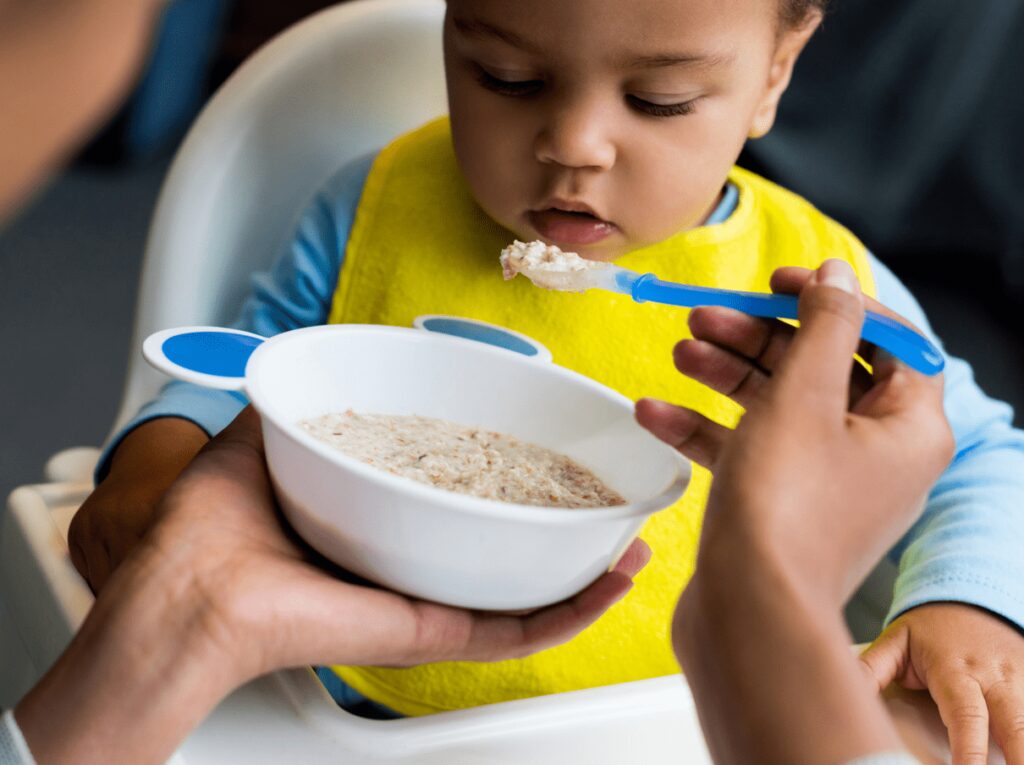
Unlocking the Power
of Early Introduction
As you embark on your incredible journey with your little one, there’s a secret superpower you hold: introducing new foods. Yes, those first spoonfuls of mashed peas and sweet potatoes are more than just baby bites—they’re the key to shaping your baby’s lifelong relationship with food.
Why is this so crucial? Well, imagine raising a mini foodie who eagerly devours broccoli, hummus, and even sushi rolls! Picture family dinners where everyone happily tries new flavors, giggling over shared discoveries.
More importantly, how and when you introduce peanuts and other common food allergens may set your baby’s immune system up to stand strong for a lifetime.
Ready to unlock this superpower? Start by knowing the risk factors for developing a peanut allergy so you can choose the right path for your little one.
Assessing your infant’s risk for developing an allergy – and what to do next.
The good news is most babies are not at risk for developing a peanut allergy.
However, the window for prevention via introduction is small, and begins early—and all babies may benefit from eating peanut foods the first year, not just those at high risk for developing peanut allergies.
As your baby’s four-month birthday approaches, it’s important to know their risk for developing a peanut allergy – so you can select the right path forward.
Which of the boxes below describes your infant?
#1
Eczema, egg allergy or both
Introduce peanut-containing foods at age 4 to 6 months
These conditions increase the risk of peanut allergy. However, research shows most can be prevented by following expert guidelines that call for introducing peanut foods at the right time — as early as four months of age —and continuing them regularly.
Before feeding your baby any peanut foods, however, discuss your situation and options with your healthcare provider. But don’t delay – because the prevention window is short and closes early.
#2
Other infants
Introduce peanut-containing foods within the first year
The new guidelines recommend introducing foods that contain peanuts along with other solid foods and in accordance with family preferences and cultural practices—within your infant’s first year of life.
It is not necessary to consult with your healthcare provider before beginning introduction. Most children will fall into this category.
Click the plus symbol (+) next to each tip to learn more
Talk to Your Doctor about Introducing Peanuts to Baby

As a new parent, provider visits in the first year often center around numbers and charts, like percentiles for height, weight and head circumference, how much baby is sleeping and more than you ever wanted to discuss about the frequency and contents of baby’s diapers! Plus, if your child had any issues at birth, like prematurity or a stay in the NICU, that can dominate time-crunched infant well visits too.
With so much already to talk about, when it’s time to introduce solid foods to your healthy baby, you may wonder how to have that conversation with your provider—especially when it comes to feeding your baby potentially allergenic foods like peanuts for the first time. It’s important to note that introducing peanut foods as early as 4-6 months can reduce the risk of developing a peanut allergy by up to 86%. In fact, the 2020-2025 Dietary Guidelines for Americans state, “Introducing peanut-containing foods in the first year reduces the risk that an infant will develop a food allergy to peanuts.”
Asking your baby’s healthcare provider early about introducing peanut foods and other common allergens may help stave off future issues, and can lead to a life of fun enjoying diverse foods together as a family! Find out more about preventing peanut allergies at PreventPeanutAllergies.org (http://preventpeanutallergies.org/) .
Starting Solid Foods
HealthyChildren.org is a great resource about hundreds of topics related to raising a child.

Here, for example, you’ll find details on starting your baby on solid foods – from how to know when she’s ready to which foods to begin with…and which to wait to try.
“Introducing peanut- containing foods in the first year reduces the risk that an infant will develop a food allergy to peanuts.”
-Dietary Guidelines for Americans,
December 2020
Click the plus symbol (+) next to each tip to learn more
Introducing peanut foods to your infants can help prevent peanut allergy
Pediatricians, allergists and others who care for babies now agree: feeding small amounts of peanut foods to infants at the right stage of their development – typically around 4-6 months of age – can have life-changing effects
Evidence continues to build about allergy prevention
These recommendations are rooted in the groundbreaking LEAP (Learning Early About Peanut) Study, in which early introduction reduced development of a peanut allergy by up to 86%. Today, guidelines from the National Institutes of Allergy and Infectious Diseases are endorsed by the American Academy of Pediatricians and championed by healthcare providers everywhere. And evidence continues to grow. In fact, the Dietary Guidelines for Americans, 2020-25 also encourage early introduction of peanuts and other foods.
It’s that important.
Parents of a newborn have so much on their plate (pardon the pun). But delaying peanut foods — even just a few weeks or months — can mean missing the window of opportunity to make a difference. This module was developed to help you and those around you know what to do and when to give your baby and others the right start.
Early peanut introduction in 4 easy steps
Follow these simple steps to help prevent a peanut allergy in your baby
Click the plus symbol (+) next to each tip to learn more
STEP 1 - Make sure your baby is ready to safely eat pureed or solid foods.

Your baby should:
- Be able to sit up on their own and show interest in table foods.
- NOT have had any allergic reaction to peanuts before.
- Be eating other solid foods. Only give peanut foods after your baby has tried 2 to 3 other foods first.
- Be healthy right now (no vomiting, diarrhea, cold, cough, or rash).
(Remember: If your baby has severe eczema or an egg allergy, talk with your baby’s doctor or other primary care provider first because these can make your baby more likely to have a peanut allergy reaction.)
STEP 2 - There are five easy ways to feed your baby a peanut-containing food.
Choose the one or ones that’s right for you.
1. Mix with water, formula or breast milk
Thin 2 tsp. of peanut butter with 2-3 tsp. hot water, formula or breast milk. Allow to cool before serving.

2. Mix with food
Blend 2 tsp. of peanut butter into 2-3 tbsp. of foods like infant cereal, applesauce, yogurt (if already tolerating dairy), pureed chicken or tofu.

3. Mix with produce
Stir in 2 tsp. of powdered peanut butter into 2 tbsp. of previously tolerated pureed fruits or vegetables.

4. Peanut snacks
Give your baby a peanut-containing teething food, such as peanut puffs.

5. Teething biscuits
Teething infants who are older and self-feeding may enjoy homemade peanut butter teething biscuits.

STEP 3 - Give your baby the peanut-containing food.

Start with just a taste:
- Offer a small amount on the tip of a spoon.
- Continue feeding other foods and watch your baby closely for 10 minutes before giving more peanut-containing food.
- Allergic reaction symptoms can include skin rash or hives (red, itchy bumps), vomiting, swelling of the lips or tongue, coughing, wheezing, or starting to look sick.
- If there is no allergic reaction, slowly give the remaining peanut-containing food.
- If your baby has a reaction, don’t feed any more peanut-containing food until you have contacted your baby’s health care provider and been told it is safe to do so. If your baby seems to be having trouble breathing, call 911. Keep in mind this is a rare reaction.
- IMPORTANT NOTE: In rare cases, food allergy symptoms can appear up to 2 hours after giving peanut food. So, keep watching your baby for 2 hours.
- Never feed whole peanuts, chunky peanut butter, or peanut butter straight from a jar to your baby! These are choking hazards.
STEP 4 - No reaction? Continue to give your baby peanut-containing food.
Continue to give your baby peanut-containing food 2 to 3 times per week.
- Continuing to provide peanut-containing foods is important for stopping a peanut allergy from developing.
- It pays to be persistent. Some babies may not show interest in solid foods at every feeding, but continue to offer food consistently. Early introduction is most effective when it starts between 4 and 6 months of age.
- DON’T DELAY the introduction of peanut foods. Delaying may increase the chance of your baby developing a peanut allergy.
More information and resources
Existing Recipe and General Videos
How to Introduce Peanuts Early
Easy Recipes with Peanut Butter for Baby and Toddler
